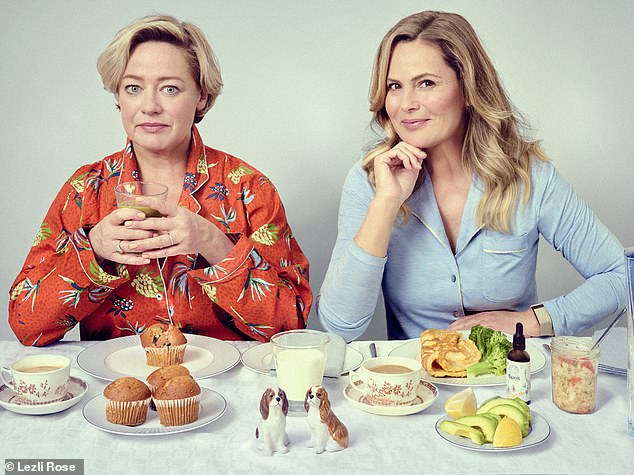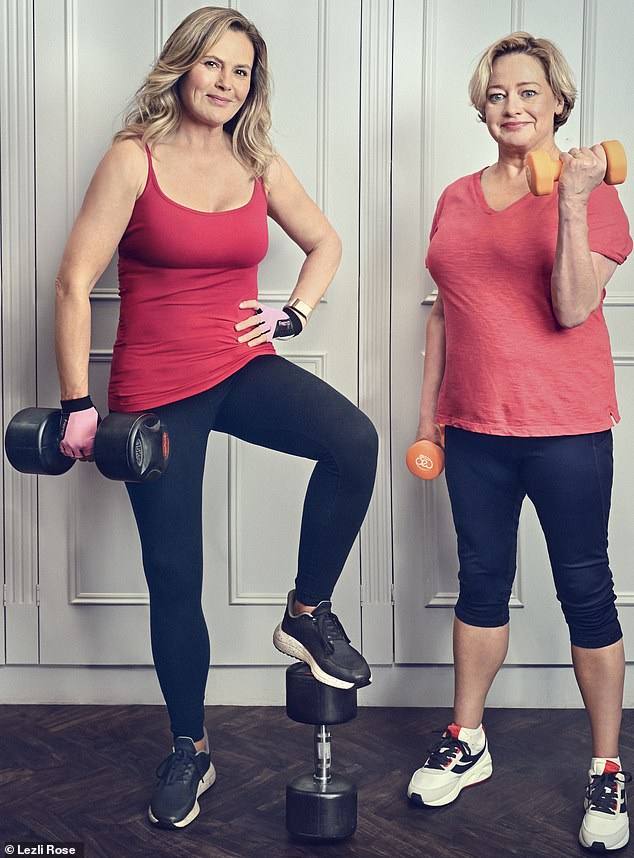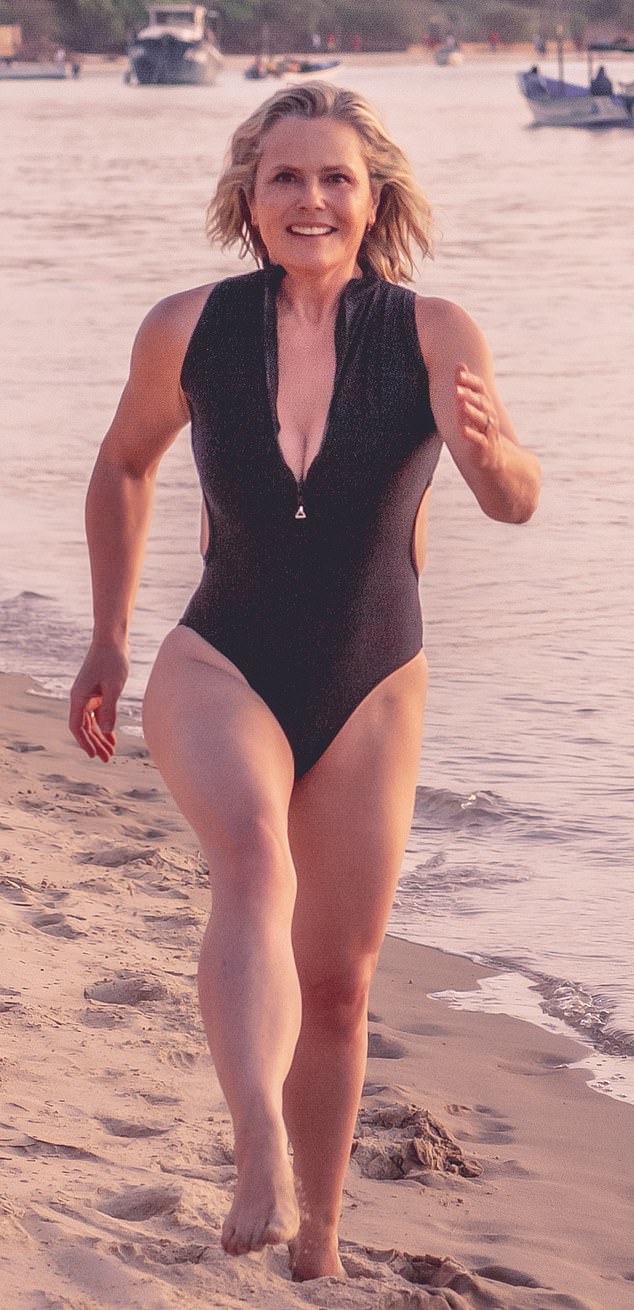Bright and early, my old friend, the beauty and wellness entrepreneur Liz Earle, is standing at my door clutching a Kilner jar with what looks like a small sponge floating in murky water.
‘I made kombucha for you,’ she says with an enthusiasm I don’t entirely share.
(The sponge, it turns out, is the Scoby, or ‘symbiotic culture of bacteria and yeast’, which is what’s used to ferment sweetened tea to make kombucha. I don’t realise at the time, but this hideous thing takes weeks to develop and is in fact a very generous gift.)
The truth is, I’d drink (almost) anything if it gave me Liz’s zip. At 61, a mother of five and a new grandmother, she honestly looks 20 years younger. Fans of her YouTube channel and her 170,000 Instagram followers will know how bright and smooth her skin is, but in person she is fizzing with energy, too.
Liz and I have been friends for 25 years – over which time she has somehow seemed to gain in vitality as I, nine years her junior, have… well, deflated.

So here’s my plan. I am going to Live Like Liz for a full eight weeks, morning to night, to see just how much I, too, can turn back the clock.
I am going to eat, drink and exercise like Liz, ‘ground myself’ in a flower bed in my pyjamas like her, and even tape up my mouth à la Liz. From my gut to my hormones, my brain to the very cells of my skin, I will follow the ‘bio-hacks’ set out in her new book A Better Second Half: Dial Back Your Age To Live A Longer, Healthier, Happier Life, which swiftly became a bestseller on its release this year.
Liz says it can’t fail, so long as I commit to it.
‘Who’s to say we can’t or shouldn’t change the way we age?’ she asks.
‘I was stronger, fitter and more capable in my 50s than I was in my 40s, so why can’t I be even more so in my 60s, 70s and beyond?’
Perhaps more significantly, after the ‘car crash of emotional wreckage’ caused by the breakdown of her second marriage, and the divorce she went through in 2020, she now says: ‘I’m happier at 61 than I was at 40.’
Career-wise, it shows. When we met back in the 1990s we were both beauty journalists. At launches for new products, I’d merrily down the free Krug while Liz sipped sparkling water. ‘Ah Bea, you were the yin to my yang,’ she says.
Now, her wellness empire has mushroomed… and I’m suffering major work anxiety, a not-unrelated financial crisis and severe sciatica.
Frankly, I look and feel knackered. My skin is dull and I have dark circles under my eyes. Physical pain interferes with my sleep, and I’ve been turning rather too readily to the sauvignon blanc to help me nod off.
Food is not a priority: I’m either not interested or craving sugar, which means I’m a good 10lb heavier than I should be.
So, can living like my rather fabulous friend make me feel as young as she looks? More to the point – can I really stick to it, kombucha and all?
‘Come on Bea, get off your backside!’ Liz demands…

Week one: I face up to my middle-age spread
Liz’s top-line diet philosophy is high-protein, low carb, meaning she’s a fan of lots of foods I love but didn’t think I should eat: butter, unprocessed meat, avocados, good quality cheese, taramasalata and thick Greek yoghurt.
High protein helps us ‘shift to a leaner, more toned shape, and lose that middle-aged spread,’ she says.
Timing matters. Liz eats two meals a day – brunch around 11am and dinner at 7pm. The order matters too: clear your plate of chicken before rice, because eating protein before carbs keeps blood sugar levels stable.
In recent years she has increased her coffee intake (before 2pm) because studies show four to five cups is ‘strongly associated with living longer’ thanks to the bioactives in coffee beans such as chlorogenic acid.
She eats wheatgerm, soya beans and nuts to up her intake of spermidine – a dietary molecule that interacts with our DNA and mimics an anti-ageing process called autophagy, which de-ages us at a cellular level.
Alcohol is basically a no-no. Liz has the ‘occasional glass’ of wine or tequila, but never more than two and never alone.
I chuck out the ready meals and plonk, roll up my sleeves and start cooking from scratch. I grill venison, roast a chicken and make soups with the leftovers.
Eating at specific times works for me – I’m never very hungry first thing – and enjoying the protein part of each meal first means I’m fuller and find it easy to cut back on my carb portions.
Gut health is a big focus, which means more fermented foods. Much to my surprise, I love the kombucha and soon start to brew my own using Liz’s Scoby. But homemade kimchi – fermented veg – is a harder sell. When a lunch guest asks me why I’m forcing myself to eat something I dislike so much, I reply solemnly: ‘Liz told me to.’
Week two: I discover I can do only 3 press-ups
I really need help with exercise because sciatica means my normal routine has gone to pot.
Thankfully, Liz reckons just ten minutes a day of exercises such as squats, lunges and press-ups is more valuable in the long term than a high-intensity gym session once a week or a long park run.
She introduces me to her personal trainer, Michael Garry, who delivers the (bombshell, but welcome) news that running any distance over 5k can ‘start to have negative effects’ on our immune system and bone strength. If you’re a runner, make it harder by speeding up your time, not increasing your distance.
At Michael’s insistence, I consult a physio about my sciatica, and then he devises a daily regime for me. I try press-ups and make it to three. Mortifying. Perseverance is clearly key. As are weights, especially in your 50s. ‘The more muscle you have, the more your bones are protected from osteoporosis, especially during midlife,’ says Michael.

For my slack and flabby upper arms, he advises shoulder presses and hammer curls, with 3kg weights in both hands. I try tricep dips off a chair, and quickly find I can increase my reps – until by week four I’m doing two sets of 15.
I work out three times a week at home. At first the routine takes 40 minutes but the more I do, the faster I do it, until the whole thing – stretching, press-ups, weights – takes just 20 minutes.
For cardio, I keep swimming twice a week. But instead of plodding up and down the pool, I start to compete with myself, speeding up the laps.
Week three: I slow the hormonal roller coaster
I’m menopausal and already on HRT, but I know I could improve how I feel, which is sluggish and foggy.
Liz introduces me to something called the ‘estrobolome’ – the specific collection of bacteria in the gut that influences how our body uses oestrogen. Put simply, some microbes improve the efficiency with which oestrogen reaches tissues around the body, meaning we use our dwindling supplies more effectively.
The best way to support your estrobolome is by eating fibre from veg, seeds and nuts, plus some of the low-sugar fruits such as apples, berries and plums. Back to the supermarket I go.
To boost the happy hormone serotonin, my saintly mentor insists I finish my morning shower with a minimum 60-second blast of icy cold water, resulting – she claims – in a ‘post-shock high’ and ‘genuine glow’.
Hmmm. I find it hard to relinquish the comfort of a hot shower and feel not happy but mutinous as I step out of the bathroom shivering.
Week four: I stand in the flower bed
Living Like Liz means getting outside first thing in the morning and standing barefoot on the grass. ‘Grounding’ apparently enables electrons from the surface of the Earth to transmit deep into the body, ‘where they have an anti-inflammatory effect’.
Liz tells me she does this in the tranquil grounds of her glorious pile in the West Country. I do it in a flower bed in my shared patio, still in my pyjamas, and feel, well, very self-conscious. Later I graduate to the park, and – look away now – tread in dog mess, which does not improve my emotional wellbeing.
She also encourages us to keep a Five Minute Gratitude Journal twice a day. ‘Gratitude is… a superpower that improves longevity and supports the immune system,’ she says.
I can’t help but think my better-off mate has rather a lot more to smile about than me but, following instructions, I write down three things I am grateful for every morning, and every night a short list of ‘good things’ that happened that day, plus another (longer) list of ‘things that are concerning me’.
My scepticism around gratitude slowly lifts as I find it does make me realise what’s important and what’s not. It helps me see that things are a lot brighter than I thought. Packing in a rush for a weekend away, I can’t find my journal and am surprised by how bereft I feel without it.
Week five: I start to sleep well
I’m a night owl – I stay up too late watching TV and end up hitting my snooze button past 8.30am… and occasionally edging towards 10am.
Liz reckons anyone can improve their sleep if they follow her routine, which means setting an evening alarm for 9pm – to remind yourself to start ‘winding down for bed’.
Emails, social media and TV are switched off, replaced by a printed book or a podcast. She takes 120g of magnesium glycinate in a milky drink half an hour before bed (and stops eating two hours before).

Liz wears a bamboo fibre nightie or pyjamas to keep warm because she sleeps with an open window, which she covers with blackout blinds and curtains, and sprinkles her pillow with a few drops of neat lavender essential oil.
I’m an e-book reader, so already failing at this routine. Still, I leave my phone charging in the kitchen and buy a regular alarm clock. The lavender oil makes me sneeze, so I spray my pillows with C. Atherley Geranium Spray instead.
Oh, and I tape my lips up – Liz shows me how when she delivers the kombucha. Forcing yourself to breathe through your nose is said to promote more restful sleep.
All of this is time-consuming and takes practise, but I find the ritual soothing. Five weeks in, I’m getting to sleep earlier than I have for years – at 10.30pm after 20 minutes drop-off time –and waking at 7.30am. How virtuous!
Week six: I crash off the wagon
I’m doing my best, but then I go for lunch with a friend who chirpily suggests a glass of wine, which turns into a bottle. And then a second. Later, with a daytime hangover, I head to M&S and find reduced dauphinoise potatoes, which become dinner.
Liz has got me on a blood sugar tracker called Lingo (£300 for two months – you jab a biosensor the size and shape of a plastic bottle top into your upper arm, and then link it to an app on your phone), which shows a massive post-potato spike and then a huge slump, which makes me tired and irritable. Who knew that such deliciousness had such a high glycaemic load?
I call Liz to ‘fess up. ‘I have the odd day when I lie in, eat too much cake and drink too much tequila,’ she says. ‘But that’s fine because you then know what to do to put it right. It’s not about being perfect.’ Phew!
Week seven: I tackle my financial mess
Re-reading my journal really helps here. By documenting what I was so worried about day by day, my perspective on it changes.
Here, in black and white, is a record of how I felt at the start of this project and how I’ve evolved.
I’ve come unstuck – in a good way. I’m not going to pretend it’s been easy because change is uncomfortable, but I realise there’s simply nothing to be gained from the worry spiral.
If freelance life is tough, and my income erratic, I’m going to do something about it. Buoyed with the confidence that comes with action, I apply for part-time admin jobs. As personal trainer Michael observes as we work out on Zoom, I wouldn’t have done this before. He’s right. Finally I’ve started to take control.
Week eight: And the winner is…
So how have eight weeks of Living Like Liz changed me?
Physically, I’m in much better shape. I’ve lost 7 lb and taken an extraordinary 5 in off my waist and 11 in off my body as a whole.
Those three pathetic press-ups have become a whopping 40 per workout, and the measly 3kg weights are now 6kg, meaning I have proper bicep definition. The sleeveless tops will be coming out again this party season.
My skin is clearer, eyes brighter and face more defined because I’ve reduced the carb-inducing bloat. I’m sleeping better and feeling infinitely less anxious.
Most remarkably – and this is really life-changing – my sciatica is almost gone and I can come off strong painkillers. I know sciatica can disappear of its own accord, but the timing is surely no coincidence. All those exercises have strengthened the muscles around my spine and buttocks and I’m convinced it’s done the trick.
I meet Liz for lunch, nervous about whether she’ll see a difference. ‘Oh wow,’ she says, taking a good look at her pupil. ‘Those arms! You definitely look younger.’
We chat for a while and she adds: ‘You also seem more content and optimistic. You have an inner glow and a halo of positivity.’
Well, yes, she would say that, wouldn’t she? (Probably. Though Liz is known for her candour, so it’s not a given.) ‘I wasn’t sure you were going to prioritise yourself enough and commit,’ she admits ‘You weren’t an easy nut to crack so I’m thrilled.’
I’m delighted with my gold star. And I’m grateful to her, which is one of the key lessons I’ve learned. Gratitude makes everything feel better.
That – along with the kombucha, ice-cold showers (which I have learned to love) and the odd tequila – are the habits I’ll hold on to. But not (shudder!) the kimchi or flower beds.
As Liz says, everyone deserves to have a better second half – and if I can do it, anyone can.
- A Better Second Half: Dial Back Your Age To Live A Longer, Healthier, Happier Life, by Liz Earle (Hodder & Stoughton, £22).

